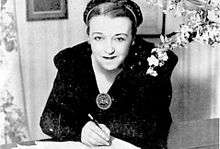María Grever
| María Grever | |
|---|---|
 | |
| Background information | |
| Birth name | Maria Joaquina de la Portilla Torres |
| Born |
September 14, 1885 León, Guanajuato, Mexico |
| Died |
December 15, 1951 (aged 66) New York City, New York, United States |
| Occupation(s) | Composer |
María Grever (14 September 1885 – 15 December 1951) was the first female Mexican musician to become a successful composer.[1]
Early life
María Joaquina de la Portilla Torres was born to a Spanish father (Francisco de la Portilla) and Mexican mother (Julia Torres) in Guanajuato, Mexico. For the first six years of her life she lived in Mexico City, moving to her father's natal city, Sevilla, in 1888. She studied music in France, with Claude Debussy and Franz Lenhard among her teachers. In 1900 she moved back to Mexico and continued her musical studies at her aunt's solfège school. In 1907, the then 22-year-old de la Portilla, married Leo A. Grever, an American oil company executive, and in 1916 became a U.S. citizen and moved to New York City where she lived for the rest of her life.[1][2]
Career
Grever wrote more than 800 songs — the majority of them boleros — and her popularity reached audiences in Latin America, Europe, and the United States. She was said to have possessed perfect pitch and wrote most of her songs in one key. Her first piece of music, a Christmas carol, was composed when she was four years old. She wrote her first song when she was 18 years old, "A Una Ola" (To a Wave), and it sold three million copies.[1]
In 1920 she began work as a film composer for Paramount Pictures and 20th Century Fox studios. Joining ASCAP in 1935, her chief musical collaborators included Stanley Adams and Irving Caesar.[3]
Grever once said: “I had to leave my country, and now in New York I am interested in Jazz and Modern Rhythms, but above all, in Mexican Music, which I long to present to the American people. I am afraid they don't know much about it. It is music worth spreading; there is such a cultural richness in Mexican Music (its Hispanic and indigenous origins and how they mix) where melody and rhythm merge. It is my wish and yearning to present the native rhythms and tunes (of Mexico) from a real perspective, but with the necessary flexibility to appeal to the universal audience".[1]
Grever's first international hit was "Júrame" (Promise, Love), a habanera-bolero interpreted in a masterly manner by tenor José Mojica.[4] Other hits continued to follow, such as "Volveré" (I Will Return); "Te quiero dijiste" (Magic Is the Moonlight), written for the 1944 Esther Williams film Bathing Beauty, as well as "Cuando vuelva a tu lado" (When I Return To Your Side) and "Por si no te vuelvo a ver"(What if I see you again).[1] Other songs of hers include "Tipitipitin" (recorded as "Ti-Pi-Tin by the Andrews Sisters), "Para Que Recordar", "Ya No Me Quieres", "Tu, Tu y Tu", "Que Dirias de Mi", "Eso Es Mentíra", "Mi Secreto", "Dame Tu Amor", "Una Rosa, Un Beso", "No Niegues Que Me Quisiste", "Despedida", "Asi" and "Alma Mia".
In 1953, Argentine singer-actress and Latin America star Libertad Lamarque portrayed Grever in Cuando me vaya (When I Leave), a biopic directed by Tito Davison.[5] Three years later, Lamarque released a best-selling tribute to Grever's most popular songs titled Libertad Lamarque canta canciones de Maria Grever.[6]
Then, in 1959 Dinah Washington recorded "What A Difference A Day Makes" (originally "Cuando vuelva a tu lado"), which became her signature song. Grever won a Grammy Award with it, and in 1998 the recording was inducted into the Grammy Hall of Fame.
Grever died in 1951 in New York. At her own request, her funerary remains were transported to Mexico City.
A biopic of Maria Grever produced by and starring the Argentinian-Mexican actress and singer Libertad Lamarque, was made in 1953 by director Tito Davison titled, "Cuando Me Vaya".
References
- 1 2 3 4 5 Rodríguez, Lee M. L. María Grever: Poeta Y Compositora. Potomac, Md: Scripta Humanistica, 1994. Print.
- ↑ https://books.google.com/books?id=HQ_UAAAAQBAJ&pg=PT134&lpg=PT134&dq=Mar%C3%ADa+Grever+%22us+citizen%22&source=bl&ots=dc5vwaDw4y&sig=Hs58pegVYr1XBkD8TMRFP40k3Z8&hl=en&sa=X&ved=0ahUKEwj29srem_vSAhUGyWMKHbhuDsUQ6AEIGjAA#v=onepage&q=Mar%C3%ADa%20Grever%20%22us%20citizen%22&f=false
- ↑ IMDb. com – María Grever entry
- ↑ Victor Library: Matrix BVE-40023 – Jurame
- ↑ IMDb.com – Cuando me vaya (1954)
- ↑ RCA Victor MKL 3020 Mono LP
External links
- María Grever Biography
- SlideShare.net – María Grever Biografía (Spanish)
- The Art Music of Mexico and Guatemala – Maria Grever (1894-1951) Biography and Images
- Victor Library – María Grever (composer)
- 1921 passport photo of Maria Grever and her children